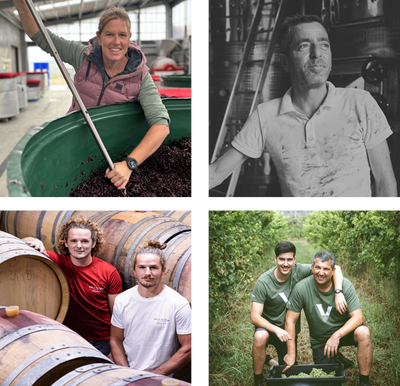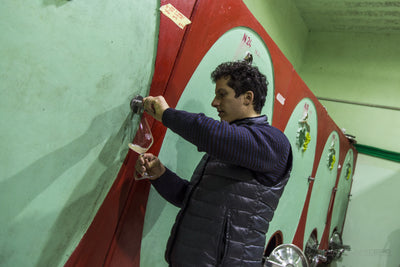Maybe you've spotted something about regenerative agriculture in a weekend newspaper, read about food producers working in radical new ways, or listened to a piece about the concept on a radio. Or perhaps it's entirely new to you - you've heard about organics, biodynamics or seen the word 'sustainable' being thrown around more and more in the last few years, but regenerative is new to you.
For many producers, in these days, to be sustainable is quite simply not enough. Green washing is rife, standards are few, and in a time of mass extinction, increasing weather extremes becoming the norm, and the shocking news we may have fewer than 70 harvests left on this earth due to loss of topsoil*, the only way to go is to look towards a regenerative approach.
This is a large subject, but I'm going to try and keep it centred around its applications in vineyards, and as concise as possible without over-simplifying these complex matters!
Definition: Regenerative agriculture is a comprehensive conservation and rehabilitation approach which starts with the soil, aiming to reverse climate change through restoring degraded soils, simultaneously working to improve their water holding capacity, reduce erosion, improving habitat and ecosystems and most importantly of all, sequester the maximum carbon.
As well as prioritising the ground beneath our feet, it also focuses on the health and well-being of farmers, workers, community and the food produced, looking at the nutrient density too. Key really, given that the average carrot today has up to 38% less calcium, phosphorus, iron, vitamin B2, and vitamin C than 50 years ago.
In the vineyard, in the same way as organic and biodynamic viticulture, the avoidance of chemical fertilisers, pesticides, herbicides, fungicides is a given, with alternative options being sought out. In the vineyards, as an alternative to pesticides, this could include integrated pest management - introducing specific beneficial insects and natural enemies to target pests. In vineyards in Constantia, South Africa, the parasitic wasp Perminutus is used to control the mealybug with great success, whilst in California, instead of introducing insects, some producers opt for planting mustard as a cover crop. Not only is it a beneficial and pretty cover crop that attracts pollinators, it also helps suppress the population of vine-root damaging nematodes by acting as a biofumigant - making the soil an inhospitable place for the pesky pests! As for one of the most common weather-related challenge, in the fight against mildew, special tissanes and preparations such as nettle tea, or horsetail can be utilised to build resilience, as well as careful canopy management.

Sheep in the vineyards at California's Ram's Gate Winery
Beyond the areas that regen ag share with the likes of organic viticulture, there lies 5 key principles:
1) Keeping the soil surface covered. Bare soil not only releases CO2, is less able to absorb it and has less water-holding capacity, and is also at risk of greater erosion. Cover crops and green manures not only help build soil fertility and organic matter, but they also help protect, aerate compacted areas, suppress weeds and provide a home for nature, like the yellow mustard in California mentioned above. Look under the vines in the height of summer in drought-affected countries like South Africa, and you'll often see a thick layer of straw mulch under the vines, a crucial aid to help retain precious water.
2) Keeping living roots in the soil. Point 1 nicely segues into point 2, which is the importance of living roots in the ground all year round. Without a root system, soil can lose all its structure, with nothing stopping it from eroding, as well as losing all vital food sources for the tiny invertebrates, mycorrhizal fungi and organisms in the soil. As a perennial plant, healthy vines guarantee living roots all year round, but greater diversity is needed with cover crops/secondary planting to maximise soil health.

Diverse cover crop in the organic vineyards at Austrian producer, Christoph Bauer. Species include the eye-catching species Phacelia, with its purple flowers - great for pollinators, as well as superb nitrogen fixing and weed suppressant properties.
3) Minimising soil disturbance. Soil is a quite extraordinary complex web of fungal networks, bacteria and other organisms. Deep tillage or ploughing disrupts this structure. No till, or even minimal tillage is far from easy, particularly in the UK, where wineries are thankfully moving away from herbicide usage to control weeds, but are hence moving to under vine cultivation. This is far better than the chemical alternative, but one must consider the issues caused by compaction, which – in turn – reduces the oxygen levels in the soil where less life can survive.
4) Maximising diversity. Here's where it can become rather challenging when it comes to vine growing. One has to remember that a vineyard is essentially an introduced, perennial, monoculture species. Rotational cropping is not an option in the same way as arable crops, and as a grower, there is just one chance a year of a harvest. Unfortunately having one crop each year not only depletes soil nutrients, but also offers pests a chance to establish a really stronghold, with no change of crop to disrupt their cycle. It further cements the importance of diverse cover crops, in line with points 2 and 3 above.
5) The integration of livestock. No, cattle are not always the enemies! I can not understate the positive impact of 'hooves on the ground,' with the introduction of carefully managed ruminants to pasture or vineyards. In the words of Bobby Gill of the Savory Institute 'it's the how, not the cow!' Even in desert like conditions, it's been shown that animal urine, manure, saliva and the act of grazing and trampling not only helps soil fertility and stimulate plant growth but also increases microbial life, carbon capture, and spread seeds too. Sheep can also be very useful with leaf thinning too. Some producers like Adi Badenhorst are also opting to work with horses over tractors. Your very own supply of manure and fewer issues with impaction in the vineyards are just two of the bonuses.

Vines almost hidden among a sea of winter legume-based cover crops at Adi Badenhorst's Paardeberg farm, Kalmoesfontein.
It's important to note that although the likes of Allan Savory or Gabe Brown may have helped move regen ag more into the spotlight in recent years, many of these practices are nothing new, and have been somewhat 'borrowed' or appropriated from traditional indigenous farming practices.
If there's anything to take from the above, it's the matter of diversity being key. The challenges with climate change may be greater than ever before, but it is so encouraging to speak to many of our producers who are working so hard to improve how they are farming, and the steps they are taking to look after the environment.
*Maria-Helena Semedo at the United Nations’ Food and Agriculture Organization forum, 2014

